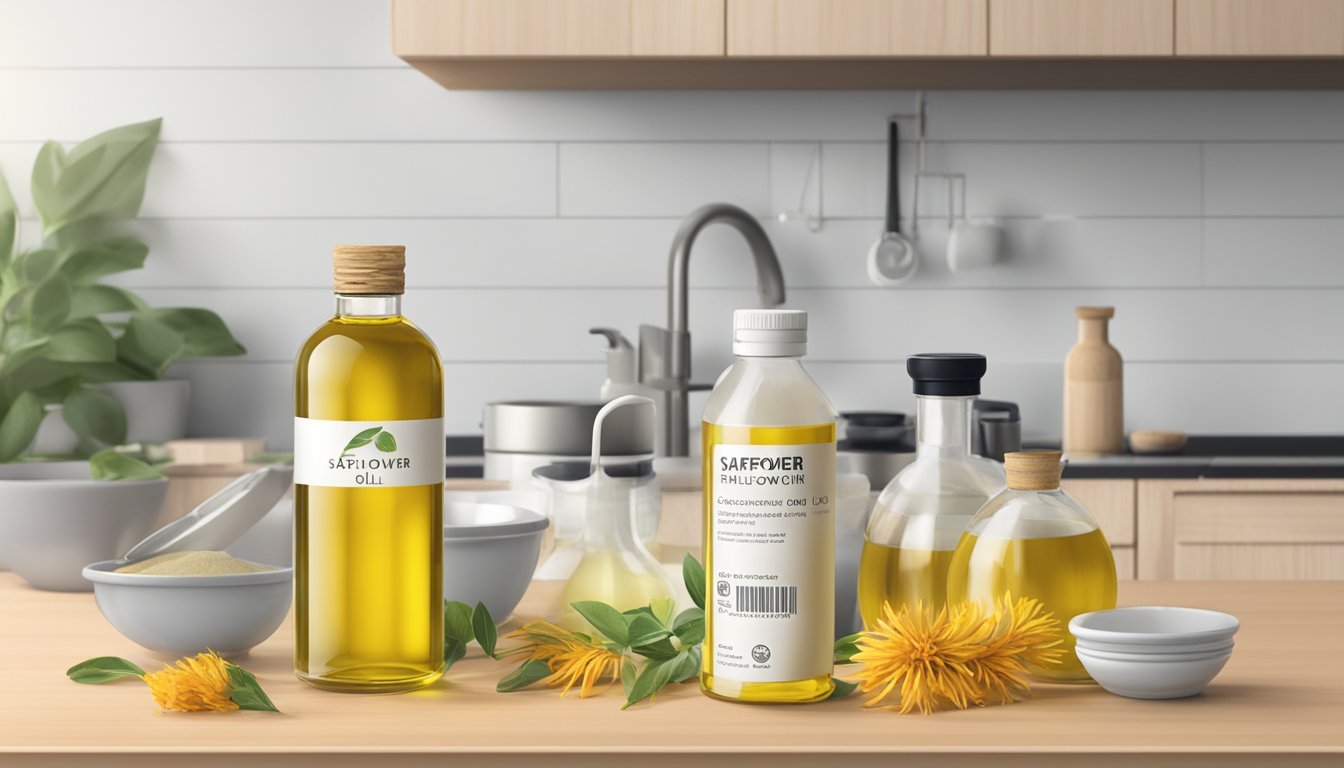How Long Does Safflower Oil Last?
Unveiling Shelf Life and Storage Tips
Safflower oil, a popular cooking and salad dressing ingredient, is prized for its neutral flavor and high smoke point. Understanding its shelf life is crucial for both food safety and maintaining the oil's quality. Unopened, safflower oil typically maintains its best quality for about two years when stored in a cool, dark place. Once the seal is broken, the clock begins to tick on the longevity of its freshness and nutritional value.
Proper storage after opening is key to extending safflower oil's usability. The oil should be kept in a tightly sealed container to prevent exposure to air, which can accelerate the oxidation process and lead to rancidity. When stored correctly at room temperature, opened safflower oil generally remains at good quality for 1 to 2 years. It’s important to note that the storage environment should be stable, away from heat sources and direct light, to maximize the oil's lifespan.
Signs of spoilage include changes in color, consistency, and smell. Should safflower oil develop an off-odor, unusual flavor, or appear cloudy, these could be indicators that the oil has gone bad and should not be consumed. Regular checks can help prevent the use of spoiled oil, ensuring that the safflower oil used in cooking contributes only its intended subtle flavor and health benefits.
Understanding Safflower Oil
Safflower oil is a health-oriented cooking oil, produced from safflower seeds, and valued for its nutritional components. Different types of safflower oil offer varied health benefits and shelf lives, making it essential to understand its characteristics.
Types of Safflower Oil
Safflower oil comes primarily in two types: high-oleic and linoleic. High-oleic safflower oil is rich in monounsaturated fats, making it stable for cooking at high temperatures and providing a longer shelf life. On the other hand, linoleic safflower oil is higher in polyunsaturated fats, which can be advantageous for certain health aspects but less stable when heated.
Nutritional Profile
The nutritional profile of safflower oil makes it a valuable addition to a balanced diet. Safflower oil is notably high in vitamin E, an antioxidant that helps protect cells from damage. Here is a breakdown of its nutritional components:
Saturated fat: It contains lower levels of saturated fats, which are typically regarded as less healthy in high amounts.
Polyunsaturated fats: These fats include essential fatty acids like linoleic acid, necessary for various bodily functions.
Monounsaturated fats: Found in high-oleic safflower oil, these fats can support heart health.
Antioxidants: With its vitamin E content, safflower oil helps combat oxidative stress in the body.
By understanding the distinct types and nutritional makeup of safflower oil, consumers can make informed choices about incorporating this oil into their diets.
Storing Safflower Oil
Proper storage extends the usability and preserves the quality of safflower oil, making understanding the ideal conditions and shelf life factors crucial for users.
Ideal Storage Conditions
To maintain the quality of safflower oil, cool and dark places are recommended for storage, away from any sources of heat such as a stove or direct sunlight, which can accelerate degradation. An opaque, airtight container is preferable as it minimizes exposure to air and light, both of which can induce rancidity. A pantry or cupboard typically provides a suitable environment with a temperature range of 50-70°F (10-21°C).
Shelf Life Factors
The shelf life of safflower oil can vary depending on several factors. When stored properly, opened bottles of safflower oil can last approximately 1 year at room temperature in the pantry. Unopened bottles, under similar conditions, can remain at best quality for about 24 months. Users should ensure that the oil is kept in a tightly sealed container to prevent oxidation and should avoid exposure to extreme temperatures, both high and low, to maintain the oil's integrity over time.
Identifying Spoilage
Determining when safflower oil has gone bad is essential for maintaining its quality and ensuring safety. Here are the distinct indicators to look for in safflower oil that signal spoilage.
Signs of Rancidity
Smell: A fresh bottle of safflower oil should have a neutral or slightly nutty aroma. Rancidity is often detectable through an off odor that can be described as sour or metallic. If the oil emits an unpleasant odor, it is a clear sign that the oil has spoiled and should not be used.
Taste: If the smell suggests rancidity, a small taste can confirm it. Safflower oil that has gone bad may have a noticeable bitter or sour taste.
Quality Aspect Fresh Safflower Oil Spoiled Safflower Oil Smell Neutral/Nutty Sour/Metallic Taste Mild Bitter/Sour Appearance/Color Consistent Cloudy/Color change
Appearance: A change in color or appearance can also indicate spoilage. Healthy safflower oil is typically a pale yellow or golden color and should be relatively clear. Any murkiness or change in color might signify that the oil is rancid.
Health Risks
Safety: Consuming spoiled safflower oil can pose health risks. While it may not cause immediate illness, it is not considered safe to consume oil that has gone rancid due to the potential formation of harmful compounds.
Danger: Over time, oils that go rancid can develop compounds that are harmful to one's health if ingested. It is important to discard any safflower oil with signs of rancidity to avoid potential health issues.
Usage Tips
Choosing the right oil for cooking can significantly affect the flavor, texture, and nutritional profile of food. This section provides practical advice on using safflower oil in various cooking applications and tips to preserve its quality for longer shelf life.
Cooking Applications
Safflower oil, due to its neutral flavor and high smoke point, is a versatile choice in the kitchen. It can be used for frying, baking, and creating salad dressings. Its neutral taste ensures that it doesn't overpower dishes, making it an excellent vehicle for herbs and spices in salad dressings. For high-heat cooking methods like deep frying and sautéing, safflower oil is preferable as it remains stable at higher temperatures, unlike oils with lower smoke points such as olive oil.
When baking, safflower oil can be a healthier alternative to butter or vegetable oil, given its lower saturated fat content. It contributes a moist, tender texture to baked goods, without adding any distinct flavor.
Maximizing Shelf Life
To extend the freshness of safflower oil:
Store the oil in an airtight, opaque container to protect it from oxidation and light damage.
Keep the oil in a cool, dry place away from heat sources.
Tighten the cap after each use to limit exposure to air.
Following these tips will help maintain safflower oil's quality on the shelf for approximately 1-2 years after opening. If the oil shows any signs of an off odor or flavor, it should be discarded to ensure both food safety and quality.
Safflower Oil Alternatives
When searching for safflower oil substitutes, it is important to consider the cooking oil's profile, which includes its level of unsaturated fats, particularly polyunsaturated fat, and its performance in various culinary applications.
Substitutes for Safflower Oil
Sunflower Oil: This is the most recommended alternative due to its similar composition. Both oils are high in polyunsaturated fats, which contribute to their health benefits. Sunflower oil also has a high smoke point, making it suitable for frying and other high-heat cooking methods.
Nutritional Comparison:
Nutrient Safflower Oil Sunflower Oil Polyunsaturated Fats High High
Vegetable Oils: In the broader category, many vegetable oils can act as a substitute. They usually have a blend of different types of unsaturated fats and often possess a neutral taste, which does not overpower the flavor of the dish.
Common Vegetable Oils:
Canola Oil
Soybean Oil
Corn Oil
Each of these alternatives shares similarities with safflower oil, ensuring that dishes retain a consistent taste and nutritional profile. When substituting, one can typically use a 1:1 ratio.
FAQs on Safflower Oil
Safflower oil is a popular cooking oil pressed from safflower seeds, known for its neutral aroma and use in high-heat cooking. It is often chosen over oils like olive because it doesn't overshadow the flavors of herbs and spices. Storage and shelf life are important factors to consider to maintain its flavor and quality.
Common Questions
How should safflower oil be stored once opened?
To preserve the quality of safflower oil after opening, it should be kept in a cool, dark place and tightly sealed. Exposure to light and heat can accelerate the oxidation process, potentially leading to rancidity.
What is the shelf life of opened safflower oil?
Opened safflower oil generally maintains its best quality for up to one year when properly stored. However, signs of spoilage include changes in color, taste, and the emergence of a rancid odor.
Can you consume safflower oil after its expiration date?
While it is not recommended, safflower oil just past its expiration date may still be safe to consume if it has been stored properly and shows no signs of spoilage. Using safflower oil past its expiration date can result in a decline in both flavor and quality.
What is the shelf life of unopened safflower oil?
An unopened bottle of safflower oil will generally stay at its best quality for about 24 months if stored in a cool, dark place. The product's expiration date can often be a reliable indicator of its shelf life.
What are the health benefits of using safflower oil?
Safflower oil contains monounsaturated fats, which can be beneficial for heart health. It also has anti-inflammatory properties and may help in lowering bad cholesterol levels. Additionally, its high smoke point makes it a suitable choice for cooking red meat and other preparations requiring high temperatures, which can help in reducing the formation of harmful free radicals.
Health Benefits and Considerations
In assessing safflower oil, it is pivotal to consider its impact on heart health, particularly concerning cholesterol levels, as well as any potential dietary concerns, including allergenic and inflammatory responses.
Positive Effects on Health
Safflower oil is predominantly identified for its fatty acid content, which includes monounsaturated and polyunsaturated fats. These fats are crucial for maintaining heart health. Specifically, safflower oil contains linoleic acid (a polyunsaturated fat), which may help to lower cholesterol levels, potentially reducing the risk of heart disease.
Monounsaturated fats: Typically found in higher concentrations in oleic acid varieties, they are beneficial for heart health.
Polyunsaturated fats: Include linoleic acid, which may aid in lowering LDL or "bad" cholesterol.
In addition to fatty acids, safflower oil also supplies antioxidants like vitamin E, which contribute to protecting cells from damage.
Dietary Concerns
When integrating safflower oil into a diet, it is important to acknowledge certain concerns. Despite its potential benefits, individuals with nut allergies may need to exercise caution, as some may have cross-reactivity to safflower oil. Moreover, while safflower oil is lower in saturated fats than some alternatives, maintaining a balance with other fat sources is vital to ensure a well-rounded diet.
Nut allergies: Individuals sensitive to nuts should consult with a healthcare provider before using safflower oil.
While some have suggested safflower oil could contribute to inflammation, current evidence does not strongly support this. However, people with inflammatory conditions should remain attentive to how their body reacts to this oil.
Inflammation and heart disease: Always monitor any dietary changes if inflammation or heart disease is a concern.
Purchase and Disposal
When selecting and disposing of safflower oil, consumers should prioritize the peak quality of the product at purchase and adhere to safe practices when the oil is no longer usable.
Buying Guide
When purchasing commercially bottled safflower oil, it’s vital to check for a best by or best if used by date. This label indicates the period during which the product is at its peak quality. It's recommended to opt for oil in a glass or opaque plastic bottle to prevent oxidation. Here's what to look for:
Date: Choose the bottle with the furthest best by date.
Packaging: Glass bottles or dark-colored plastic to protect from light.
Size: Smaller bottles if not used frequently, to ensure freshness.
Safe Disposal of Used Oil
Once safflower oil becomes rancid, it should be discarded properly to ensure safety and environmental responsibility:
Do Not Pour Down the Drain: This can cause plumbing issues and environmental harm.
Check with local recycling programs for guidelines on disposing of cooking oil. Some areas provide facilities for recycling.
If recycling is not available:
Seal the oil in a container and discard with regular trash.
Absorb small amounts with paper and dispose of in a sealed bag.
Following these guidelines will help maintain safety and reduce one's environmental footprint.








